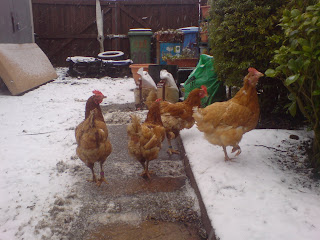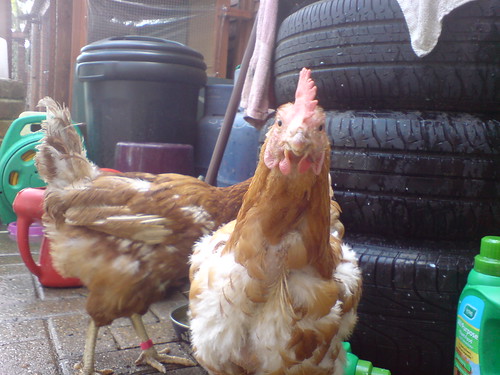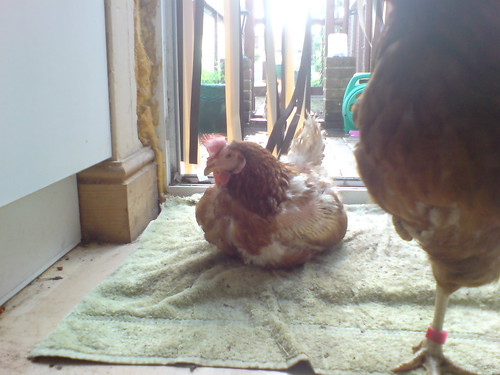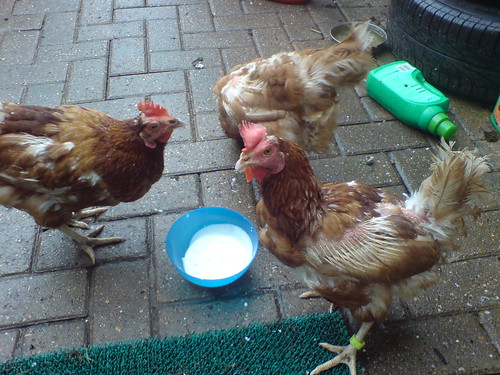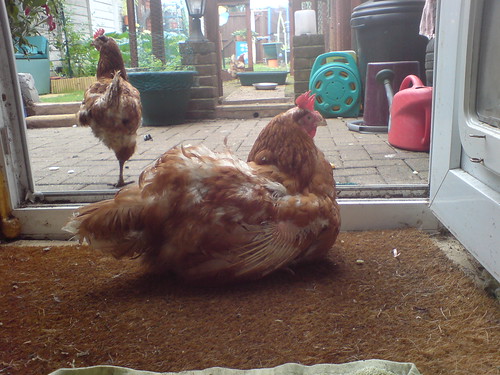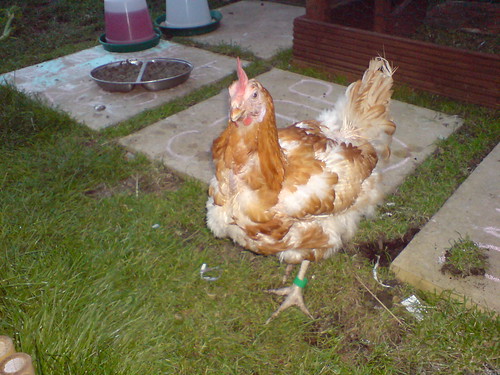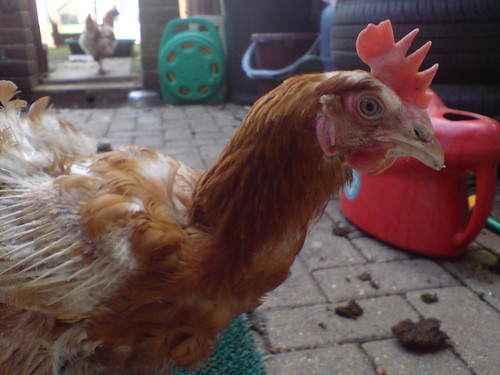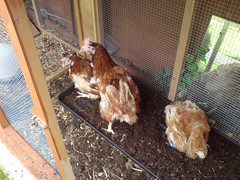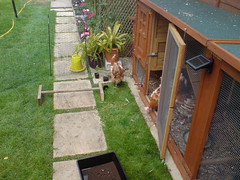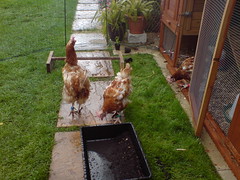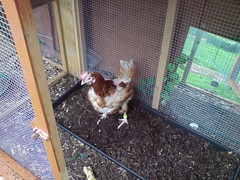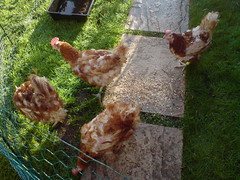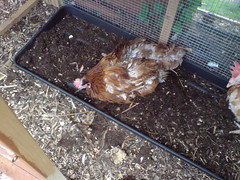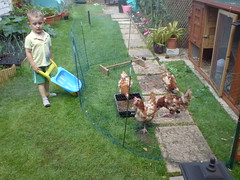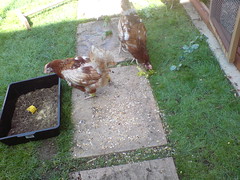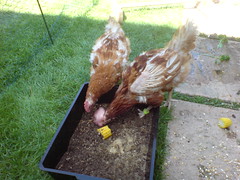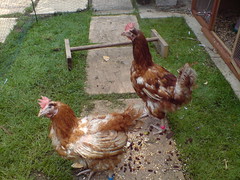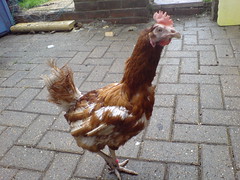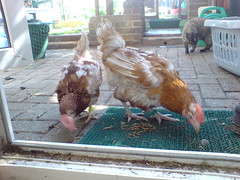Hi,
Thanks for visiting.
I now have a new address www.crispysnips.com
Please visit there for further posts.
Thank you!!
A blog about me, my family and our animals. We're just going along trying to catch a break. Until then, here we are.
Tuesday 6 September 2011
Friday 2 September 2011
The hens home improvements
I've been a bit busy recently, so sorry about the quiet time!
I thought I'd write about the wonderful work my husband has done on our hens pen this week.
For sometime now, we've had some waterproof material covering half the pen to give the girls some extra shelter and keep the ground a bit drier.
My husband brought some waste material (solid sheets of nylon) home from work to make a solid roof for the pen in preparation for winter.
We have 2 extra hens this year, so we'll need more dry space and they'll need to spend more time in the pen when the weather is awful.
Also, our back garden gets a bit swampy and the grass suffers, so last year I kept them in their pen for a couple of weeks at the beginning of spring.
Just to give the grass a chance to grow, because as fast as the new shoots were growing, the hens were eating them faster!!
I re-seeded the lawn, just to make sure there would be plenty of grass for them for the summer and there has been.
So, my husband drew up a rough design, we bought some hinges, screws and bits of wood and got to work.
I helped, held stuff, passed stuff but he did all the tricky measuring and cutting. Being an engineer, he's much better at that sort of stuff than me!
Here is the supporting beam for the doors.
There will be two doors, one at each end.
The doors will open from a solid section,
with the hinges over this piece of wood.
I have also put some sharp sand down on
the floor to refill some of the holes that
had been dug, and the girls love to pick the
little bits of stones out of the sand.
Here are the two sheets of solid nylon
laid in place, ready for cutting.
You can even see the guide line already
drawn down the middle.
Here is my husband cutting the sheets,
ready to put the hinges on.
This nylon is so strong he was able to
sit on top of it whilst he cut.
It should easily take the weight of the snow
and provide the girls with a good secure
roof.
All cut and ready for the hinges!
As you can see by the sand, the girls
have already tried to re-arrange everything.
They are so helpful.
In case, anyone is wondering, they
weren't at all bothered by
the circular saw sounds.
Hinges on and working perfectly!
Yes, that's me.... LOL! The doors are quite
heavy, but that works fine for me.
My husband has even made some
struts to hold them open, as they don't go all
the way back.
Clever guy!
Here is V8 helping my husband to
finish off. She's a nosey thing and
loves to be involved in everything, but
then, don't they all......
Here is V8 again, this time helping
to carry a piece of wood.
She prefers to supervise and I think she does
a pretty good job.
This wood was used to make some perching
areas out in the pen.
They have a little climbing frame thing
out there now!
Done, just got the tidying up to do.
You can see Mel in the pen checking it
out.
She's the top bird, so needs to see
everything first.
The others were happy grazing and rolling
in the flowerbed.
We have also put some bubble wrap around the outside of the pen just to keep any driving rain out.
We wanted to make sure our girlies stay nice and dry.
Thanks for reading!
I thought I'd write about the wonderful work my husband has done on our hens pen this week.
For sometime now, we've had some waterproof material covering half the pen to give the girls some extra shelter and keep the ground a bit drier.
My husband brought some waste material (solid sheets of nylon) home from work to make a solid roof for the pen in preparation for winter.
We have 2 extra hens this year, so we'll need more dry space and they'll need to spend more time in the pen when the weather is awful.
Also, our back garden gets a bit swampy and the grass suffers, so last year I kept them in their pen for a couple of weeks at the beginning of spring.
Just to give the grass a chance to grow, because as fast as the new shoots were growing, the hens were eating them faster!!
I re-seeded the lawn, just to make sure there would be plenty of grass for them for the summer and there has been.
So, my husband drew up a rough design, we bought some hinges, screws and bits of wood and got to work.
I helped, held stuff, passed stuff but he did all the tricky measuring and cutting. Being an engineer, he's much better at that sort of stuff than me!
Here is the supporting beam for the doors.
There will be two doors, one at each end.
The doors will open from a solid section,
with the hinges over this piece of wood.
I have also put some sharp sand down on
the floor to refill some of the holes that
had been dug, and the girls love to pick the
little bits of stones out of the sand.
Here are the two sheets of solid nylon
laid in place, ready for cutting.
You can even see the guide line already
drawn down the middle.
Here is my husband cutting the sheets,
ready to put the hinges on.
This nylon is so strong he was able to
sit on top of it whilst he cut.
It should easily take the weight of the snow
and provide the girls with a good secure
roof.
All cut and ready for the hinges!
As you can see by the sand, the girls
have already tried to re-arrange everything.
They are so helpful.
In case, anyone is wondering, they
weren't at all bothered by
the circular saw sounds.
Hinges on and working perfectly!
Yes, that's me.... LOL! The doors are quite
heavy, but that works fine for me.
My husband has even made some
struts to hold them open, as they don't go all
the way back.
Clever guy!
Here is V8 helping my husband to
finish off. She's a nosey thing and
loves to be involved in everything, but
then, don't they all......
Here is V8 again, this time helping
to carry a piece of wood.
She prefers to supervise and I think she does
a pretty good job.
This wood was used to make some perching
areas out in the pen.
They have a little climbing frame thing
out there now!
Done, just got the tidying up to do.
You can see Mel in the pen checking it
out.
She's the top bird, so needs to see
everything first.
The others were happy grazing and rolling
in the flowerbed.
We have also put some bubble wrap around the outside of the pen just to keep any driving rain out.
We wanted to make sure our girlies stay nice and dry.
Thanks for reading!
Friday 26 August 2011
The digestive journey of hen food!
Hello,
I thought I'd start to collect together some of the information I have found about hens. I thought it maybe useful to have it all in one place, for myself and anyone else who needs it.
Firstly, lets look at where everything is stored, inside a hen.
I thought I'd start to collect together some of the information I have found about hens. I thought it maybe useful to have it all in one place, for myself and anyone else who needs it.
Firstly, lets look at where everything is stored, inside a hen.
This diagram gives you a good view as to wear all of the organs are placed inside your hen. When looking at separate processes (digestion, respiration, circulation etc..) it is a good idea to also have an idea of where the other organs are.
The most important thing to a hen is eating as it is with most animals and people! The hen uses a mixture of gravity, mechanical action and chemicals (enzymes) to eat.
The most important thing to a hen is eating as it is with most animals and people! The hen uses a mixture of gravity, mechanical action and chemicals (enzymes) to eat.
✯ The beak - the hen pecks, and picks at food. As she takes it into her beak saliva is added. The saliva contains enzymes which begin to break the food down.
✯ The food passes down to the crop using gravity alone.The hen has no teeth and doesn't chew.
✯ The crop - This is a pouch at the base of the neck, found on the front of the left side of the breast. As the hen eats, it fill with food and will become more visible. As the hen sleeps, the crop breaks down the food and empties. When the hen wakes up in the morning, the crop should be empty. The crop is also responsible for sending a hunger signal to the brain.
✯ The oesophagus - the food leaves the crop and passes down the oesophagus to the glandular stomach or proventriculus.
✯ The proventriculus - this is where more enzymes and stomach acids are added to the food to break it down into a form where the nutrients maybe extracted by the intestines. It is fairly small but it's richly supplied by glands and lymphoid tissues.
✯ The gizzard - the hen eats grit which collects in a muscular stomach called the gizzard. As the food passes into the gizzard from the proventriculus, it is ground down by the muscular action before it enters the small intestine.
✯ The small intestine - this, as with most animals, consists of three parts, the duodenum, jejunum and the ileum. The largest part of the small intestine, is the duodenum. This is supplied with enzymes secreted from the pancreas. The food is broken down further with the action of these enzymes (which break down proteins), before it passes on to the large intestine.
✯The caeca - these are two blind ended tubes which provide space for fermentation. Fermentation is a process where food is subject to microbial breakdown. The caeca is responsible for the mustard to light brown foamy droppings that your hen produces, usually at a rate of about 1 in 10 droppings.
✯The caeca - these are two blind ended tubes which provide space for fermentation. Fermentation is a process where food is subject to microbial breakdown. The caeca is responsible for the mustard to light brown foamy droppings that your hen produces, usually at a rate of about 1 in 10 droppings.
✯ The large intestine - This is quite short, consisting of two main parts, the colon and the rectum. At the end of the large intestine, is the cloaca or vent.
✯ The cloaca or vent - This is an opening shared by the urinary and the digestive tract.
✯ The liver - Nutrients are absorbed through the walls of the alimentary canal (digestive tract). The liver secretes bile which aids in fat digestion. The liver is a major detoxification organ for the body.
The pancreas - The pancreas secrets enzymes and produces hormones. The pancreas is responsible for producing insulin and controlling the bloods sugar level.
It is important to note at this point, that the hen does not urinate. The fecal matter and urine come out as one neat little parcel.
Here is another diagram, showing only the bits I have mentioned above. I didn't draw this, but I thought it's a nice simple diagram that shows everything fairly clearly.
This table shows the basic nutritional requirements for laying hens and meat hens at different stages of their life.
Meeting the nutritional needs of your hen
Now that we've looked at the digestive system, organs, associated organs and processes, I thought now might be a good time to look at what your hen actually needs to eat in order to stay healthy. Like many animals, there is a fairly good range of 'complete foods' available, so you don't need to worry too much.
What your chicken needs to eat, will also depend on what you're keeping her for, is she a meat hen or a laying hen. Most hens will fall into either of these two categories, even if she's a pet hen, she'll still most likely be laying eggs.
Initially the meat hen requires a large protein intake, this is because most meat hens will have reached the required weight by just 7 weeks of age.
There are six main nutrients/elements that your hen needs in order to stay healthy. These are pretty much the same for most animals.
Carbohydrates - this is the main source of energy within food. For hens, most of the carbohydrates will come from grains, whatever type of feed you choose (pellets, mash, whole grains)
Proteins - The building blocks. They are required for the maintenance and healthy production of tissues, whether it's muscle or organ tissue. They are also necessary for the production of hormones and, proteins also provide a small amount of energy.
I thought it maybe interesting to see what was suggested. I would imagine, that trying to make up your own hen feed would be a very expensive option for the backgarden hen keeper.I have paid between £7.99 and £10 for a 20KG sack of layers ration (pellets, mash and crumb). Also whole grains have a very short shelf life, so unless you had a large flock it probably wouldn't be viable. Also when feeding a whole grain diet, the access to grit is even more important.
If your hens are free ranging, they'll also have access to grass, bugs, soil and other leafy plants which they will quite happily 'trim' for you!
Feed supplements, particularly if you have ex-battery hens or hens in poor condition, are important. They can bolster the diet and are found as feed, water or even directly administered drops. One I have always used is Poultry Spice
The laying hen however, doesn't require quite as much protein whilst she is growing. Once she is grown and at 'point of lay' (around 16-21 weeks of age) she will then require a lot more calcium in order to make those lovely egg shells!
There are six main nutrients/elements that your hen needs in order to stay healthy. These are pretty much the same for most animals.
Carbohydrates - this is the main source of energy within food. For hens, most of the carbohydrates will come from grains, whatever type of feed you choose (pellets, mash, whole grains)
Proteins - The building blocks. They are required for the maintenance and healthy production of tissues, whether it's muscle or organ tissue. They are also necessary for the production of hormones and, proteins also provide a small amount of energy.
Fats - Another source of energy for the hen, they also provide the fatty acids which are essential for some bodily processes.
Minerals - There are many of these and are also known as mineral nutrients. Dietary minerals are inorganic, which means they don't contain carbon.
Vitamins - These are organic chemicals, meaning they do contain carbon. There are a wide range of vitamins, each having a different action within the body. It is important to make sure your hen receives a broad spectrum of vitamins within her diet. A good way of doing this, is to feed a general vitamin supplement.
Water - Essential for all bodily functions. The hens body is about 65-70% water, so constant access to fresh drinking water is essential.
The hens feed intake requirement will depend on many things such as age, breed/type, ambient temperature, free range or not, the general health of the bird and of course the sex of the bird (but I'm focusing on hens).
Many things are used to make up a commercial layers ration. These include (but not exclusively) corn, soyabean, rice bran, barley and some even use animal by products, such as bone meal.
It is important to read the label when buying feed, generally, though the choice between pellets, crumbs or mash will be according to your birds preference, as they will most likely contain the same ingredients (if they are from the same manufacturer).
I found this recipe for homemade chicken feed on the Greener Pastures Farm website.
Minerals - There are many of these and are also known as mineral nutrients. Dietary minerals are inorganic, which means they don't contain carbon.
Vitamins - These are organic chemicals, meaning they do contain carbon. There are a wide range of vitamins, each having a different action within the body. It is important to make sure your hen receives a broad spectrum of vitamins within her diet. A good way of doing this, is to feed a general vitamin supplement.
Water - Essential for all bodily functions. The hens body is about 65-70% water, so constant access to fresh drinking water is essential.
The hens feed intake requirement will depend on many things such as age, breed/type, ambient temperature, free range or not, the general health of the bird and of course the sex of the bird (but I'm focusing on hens).
Many things are used to make up a commercial layers ration. These include (but not exclusively) corn, soyabean, rice bran, barley and some even use animal by products, such as bone meal.
It is important to read the label when buying feed, generally, though the choice between pellets, crumbs or mash will be according to your birds preference, as they will most likely contain the same ingredients (if they are from the same manufacturer).
I found this recipe for homemade chicken feed on the Greener Pastures Farm website.
2 parts whole corn (in winter this is increased to 3 or 4 parts)
3 parts soft white wheat
3 parts hard red winter wheat
1 part hulled barley
1 part oat groats
1 part sunflower seeds (in winter this is increased to 2 parts)
1 part millet
1 part kamut
1 part amaranth seeds
1 part split peas
1 part lentils
1 part quinoa
1 part sesame seeds
1/2 part flax seeds
1/2 part kelp granules
free choice of granite grit
free choice of oyster shellI thought it maybe interesting to see what was suggested. I would imagine, that trying to make up your own hen feed would be a very expensive option for the backgarden hen keeper.
If your hens are free ranging, they'll also have access to grass, bugs, soil and other leafy plants which they will quite happily 'trim' for you!
Feed supplements, particularly if you have ex-battery hens or hens in poor condition, are important. They can bolster the diet and are found as feed, water or even directly administered drops. One I have always used is Poultry Spice
This can be found quite easily at most places who stock poultry feed or online.
It is made in this powder form or as a water additive. I have tried both and my girls seem to prefer the powder, which you simply add to feed.
Another supplement I personally like to feed my hens is garlic. It's a brilliant 'wonder' herb in my opinion. It also helps to neutralise the droppings (make them less wiffy) and can act as a mild bug deterrent. I have read in a few places that the garlic taste will transfer to the egg. I have not found this to be the case, my hens get a good scoop of it everyday in their feed and I have yet to find a garlic flavoured egg.
Poisonous plants. I feel at this point it is important to mention that there are some plants that are poisonous to hens. I found a list on Omlet which lists these plants. It is important to make sure your hen doesn't have access to these. Most poisonous plants don't taste very nice, but hens are little feathery dustbins and will have a go at eating most things, so please, check your little patch and remove them. Don't use weedkiller as this of course, is also poisonous to hens.
Poo.... now when it comes out, it has many, many different looks. I think it's just easier if I give you this link poo pictures , which shows many photos of chicken poo, normal, sick and the foamy caecal poo. Poo can give you a good indication of how the hen is feeling, so it's important to take note of any abnormalities.
So that is pretty much the hen, what she eats, where it goes, what happens to it and what happens when it comes out the other end!
Thanks for reading, I hope you found this useful.
It is made in this powder form or as a water additive. I have tried both and my girls seem to prefer the powder, which you simply add to feed.
Another supplement I personally like to feed my hens is garlic. It's a brilliant 'wonder' herb in my opinion. It also helps to neutralise the droppings (make them less wiffy) and can act as a mild bug deterrent. I have read in a few places that the garlic taste will transfer to the egg. I have not found this to be the case, my hens get a good scoop of it everyday in their feed and I have yet to find a garlic flavoured egg.
Poisonous plants. I feel at this point it is important to mention that there are some plants that are poisonous to hens. I found a list on Omlet which lists these plants. It is important to make sure your hen doesn't have access to these. Most poisonous plants don't taste very nice, but hens are little feathery dustbins and will have a go at eating most things, so please, check your little patch and remove them. Don't use weedkiller as this of course, is also poisonous to hens.
Poo.... now when it comes out, it has many, many different looks. I think it's just easier if I give you this link poo pictures , which shows many photos of chicken poo, normal, sick and the foamy caecal poo. Poo can give you a good indication of how the hen is feeling, so it's important to take note of any abnormalities.
So that is pretty much the hen, what she eats, where it goes, what happens to it and what happens when it comes out the other end!
Thanks for reading, I hope you found this useful.
Thursday 25 August 2011
Our ex-battery hens... Their first winter!
Ok, I've been dying to put some snow hen photos on. The last post I told you about Terri and her foot infection. She made a full recovery just in time for the really cold stuff.
I was a little worried I wouldn't get her back out in time for the cold weather, but thankfully we managed it.
Sadly though, this was Terri's first and last winter, as we lost her on New Years day. I wrote about it later on in the blog, happy stuff first!!
Here are all 4 of the girls after I'd just let them out. We had a bit of snow overnight, but this was just the beginning.
You can see them all sticking together, checking it out.
Their feathers really started to come through as the weather got colder.
I did clear the paths off for them, and they tended to stay on the clear bits rather than walking in the snow. I don't blame them!
Here is Mel (again!) You can see how well she looks now! She is still missing some feathers, mostly from her undercarriage, but she almost looks like a 'normal' hen.
She's stood next to the bush sheltering from the snow, she doesn't really like getting wet!
You can see her face and comb are now totally red as they should be.
Here is Mel again, being brave, as she is, and walking through the snow.
It's still only a dusting at the moment, but this is the first time they've seen snow.
Makes me very proud to watch them taking it all in their stride.
They had been out for a little while at this point, so they've split up as normal to go about their daily business!
The snow starts to come down a little faster now and the girls retreat to the safety of the pen.
I left the gates open so they could walk about if they wanted to, but they stayed pretty close to the run and houses.
You can see all four of them here together again. I guess as the weather changed they became unsure again and re-grouped!
Here is Chicken 11, who I think was the least impressed with the snow....
This is the perch my husband made for them, just to give them something to sit on and to add some variety to their pen.
Chicken 11 is more than happy to perch here out of the snow.
She still has the least feathers at this point, but didn't show any signs of being cold. They kept very active throughout the cold weather.
Here is Chicken 11 the next morning, we had a fair bit of snow overnight (this is pretty deep snow for us here).
Chicken 11 shows of some high stepping action as she walks down the garden. Pretty brave for her to go off on her own, I thought.
The temperature got down to -10 here, but the girls were fine. They snuggle up and if you open the door at night, the heat coming from them is amazing!
Here is Chicken 11 coming back again, obviously not impressed....
I did clear the paths off for them again, which did cheer up up a little.
She was a tough bird to please!
I loved the snow as all of their feet were sparkling clean all of the time!
You can see how red little 11's face and comb are now. Her comb never made it into an upright position, but it's a lot higher than when she first came to us.

Here are the girls walking back into the run.... there's not much to do out in the snow, so they come back inside for some breakfast.
During the cold weather, I was feeding them warm mash.
This is simply made by buying layers mash (works with pellets but needs more mixing!) and adding hot water to make a sort of 'Ready Brek' for them. They really have no trouble keeping warm in the winter, but they did seem to enjoy the extra effort that I put into preparing their meals!
I love this photo of Crispy! She has blossomed and is has all of her feathers. Look how lovely and dark she is!
She is confident, happy and very sociable now and lays really lovely, smooth dark brown eggs.
I can tell who's eggs are who now, as they are all slightly different.
Crispy wasn't too fussed about the snow and just got on with it.
 Here is Chicken 11 (left), Terri (right) and Crispy (front) having a meeting in the middle of the garden.
Here is Chicken 11 (left), Terri (right) and Crispy (front) having a meeting in the middle of the garden.
The snow was a couple of inches deep by now and you can almost see them thinking, "where's the grass?"
But the happiness was short lived, as you'll read below.
Sorry if anyone finds this upsetting.
The above picture is Terri. I thought she should get a large picture as this was the last photo we took of her before she had to be put to sleep.
It was New Years day, I'd put them to bed the night before as normal, everything was fine. When I let them out in the morning, I noticed Terri wasn't herself, she was quiet, hunched and staggering.... I watched her for a while to see if she changed but she got worse.
I could hear her making a gurgling sound as she breathed and I knew that it was serious. I sat down with her on my knee and could feel her crop was huge and filled with fluid. I knew what it was straight away, sour crop (I'll write about it after the story!).
I tried to empty some of the fluid out by holding her upside down and massaging the liquid out of her mouth. I stopped every few moments to allow her to breathe, as just like us, they can't breathe and vomit at the same time!
The smell was awful, it just smelt like bile and it was green. Something hadn't cleared out of her crop overnight as it should, and had now fermented. The smell was fermented food....
I called the vet as the gurgling sound was very worrying, I feared that she had inhaled some of the liquid. We got to the vets (£80 just to see us, being New Years day!) and my fears were confirmed.
We agreed the best thing would be to put her to sleep, sour crop is quite easily fixed if caught early, but she'd inhaled the liquid and was suffering.
I was absolutely devastated..... she was the first hen we'd lost and after coming so far, gutted. I think I cried all day..... still makes me cry now just thinking about it.
We bought her body home and buried her in the flower bed where she loved to dig and dust bathe. Lucas dug a really deep hole for her, as we didn't really want the other girls digging her up again.
So now we just had 3 hens. It was really weird only seeing 3 birds out in the garden, Terri had really come out of herself since being in the house whilst she recovered from her foot infection. Her feathers had really come through and she was a picture of health.
Sour Crop - As mentioned above, sour crop is the result of the hens crop (food pouch in her chest area, kind of a halfway house between mouth and stomach) not emptying as it should overnight. The food then ferments, resulting in a fungal infection.
❦ Keeping grit available at all times - chickens can't chew... they use grit in their gizzard to grind up their food up. If they can't grind it up it won't go through.
❦ Avoid keeping hens on long grass - this is harder to break down as long grass is tougher and more fibrous than the short grass.
❦ Using ACV (apple cider vingear) - this is a health tonic for hens, it helps improve condition, aids digestion. Add this to their water once a month, but more or less won't hurt!
❦ I also feed garlic granules to my hens. I believe garlic is super, good for the blood, keeps bugs and worms at bay and generally boosts health.
I hope that you have found this useful and I hope no-one has to go through what we went through with Terri.
She has left a hole that will never be filled.
Thanks for reading.
I was a little worried I wouldn't get her back out in time for the cold weather, but thankfully we managed it.
Sadly though, this was Terri's first and last winter, as we lost her on New Years day. I wrote about it later on in the blog, happy stuff first!!
Here are all 4 of the girls after I'd just let them out. We had a bit of snow overnight, but this was just the beginning.
You can see them all sticking together, checking it out.
Their feathers really started to come through as the weather got colder.
I did clear the paths off for them, and they tended to stay on the clear bits rather than walking in the snow. I don't blame them!
Here is Mel (again!) You can see how well she looks now! She is still missing some feathers, mostly from her undercarriage, but she almost looks like a 'normal' hen.
She's stood next to the bush sheltering from the snow, she doesn't really like getting wet!
You can see her face and comb are now totally red as they should be.
Here is Mel again, being brave, as she is, and walking through the snow.
It's still only a dusting at the moment, but this is the first time they've seen snow.
Makes me very proud to watch them taking it all in their stride.
They had been out for a little while at this point, so they've split up as normal to go about their daily business!
The snow starts to come down a little faster now and the girls retreat to the safety of the pen.
I left the gates open so they could walk about if they wanted to, but they stayed pretty close to the run and houses.
You can see all four of them here together again. I guess as the weather changed they became unsure again and re-grouped!
Here is Chicken 11, who I think was the least impressed with the snow....
This is the perch my husband made for them, just to give them something to sit on and to add some variety to their pen.
Chicken 11 is more than happy to perch here out of the snow.
She still has the least feathers at this point, but didn't show any signs of being cold. They kept very active throughout the cold weather.
Here is Chicken 11 the next morning, we had a fair bit of snow overnight (this is pretty deep snow for us here).
Chicken 11 shows of some high stepping action as she walks down the garden. Pretty brave for her to go off on her own, I thought.
The temperature got down to -10 here, but the girls were fine. They snuggle up and if you open the door at night, the heat coming from them is amazing!
Here is Chicken 11 coming back again, obviously not impressed....
I did clear the paths off for them again, which did cheer up up a little.
She was a tough bird to please!
I loved the snow as all of their feet were sparkling clean all of the time!
You can see how red little 11's face and comb are now. Her comb never made it into an upright position, but it's a lot higher than when she first came to us.

Here are the girls walking back into the run.... there's not much to do out in the snow, so they come back inside for some breakfast.
During the cold weather, I was feeding them warm mash.
This is simply made by buying layers mash (works with pellets but needs more mixing!) and adding hot water to make a sort of 'Ready Brek' for them. They really have no trouble keeping warm in the winter, but they did seem to enjoy the extra effort that I put into preparing their meals!
I love this photo of Crispy! She has blossomed and is has all of her feathers. Look how lovely and dark she is!
She is confident, happy and very sociable now and lays really lovely, smooth dark brown eggs.
I can tell who's eggs are who now, as they are all slightly different.
Crispy wasn't too fussed about the snow and just got on with it.
 Here is Chicken 11 (left), Terri (right) and Crispy (front) having a meeting in the middle of the garden.
Here is Chicken 11 (left), Terri (right) and Crispy (front) having a meeting in the middle of the garden.The snow was a couple of inches deep by now and you can almost see them thinking, "where's the grass?"
But the happiness was short lived, as you'll read below.
Sorry if anyone finds this upsetting.
The above picture is Terri. I thought she should get a large picture as this was the last photo we took of her before she had to be put to sleep.
It was New Years day, I'd put them to bed the night before as normal, everything was fine. When I let them out in the morning, I noticed Terri wasn't herself, she was quiet, hunched and staggering.... I watched her for a while to see if she changed but she got worse.
I could hear her making a gurgling sound as she breathed and I knew that it was serious. I sat down with her on my knee and could feel her crop was huge and filled with fluid. I knew what it was straight away, sour crop (I'll write about it after the story!).
I tried to empty some of the fluid out by holding her upside down and massaging the liquid out of her mouth. I stopped every few moments to allow her to breathe, as just like us, they can't breathe and vomit at the same time!
The smell was awful, it just smelt like bile and it was green. Something hadn't cleared out of her crop overnight as it should, and had now fermented. The smell was fermented food....
I called the vet as the gurgling sound was very worrying, I feared that she had inhaled some of the liquid. We got to the vets (£80 just to see us, being New Years day!) and my fears were confirmed.
We agreed the best thing would be to put her to sleep, sour crop is quite easily fixed if caught early, but she'd inhaled the liquid and was suffering.
I was absolutely devastated..... she was the first hen we'd lost and after coming so far, gutted. I think I cried all day..... still makes me cry now just thinking about it.
We bought her body home and buried her in the flower bed where she loved to dig and dust bathe. Lucas dug a really deep hole for her, as we didn't really want the other girls digging her up again.
So now we just had 3 hens. It was really weird only seeing 3 birds out in the garden, Terri had really come out of herself since being in the house whilst she recovered from her foot infection. Her feathers had really come through and she was a picture of health.
Sour Crop - As mentioned above, sour crop is the result of the hens crop (food pouch in her chest area, kind of a halfway house between mouth and stomach) not emptying as it should overnight. The food then ferments, resulting in a fungal infection.
It can be identified by a large crop, which feels a bit like a water balloon. When the birds beak is opened, you'll be able to smell a putrid stench (a bit like vomit).
If you feel able, then hold the hen upside down (not by her feet) and massage the crop to encourage the liquid to come out of the mouth.
You need to make sure you give the hen a chance to breathe or you'll suffocate her. If you don't feel confident enough to do this, then seek help, either from a vet or an experienced friend.
This may need to be repeated a few times before the crop stops refilling.
Feeding natural yoghurt can help to return the crop back to normal as can adding apple cider vinegar to the hens drinking water.
I have also read that feeding natural yoghurt with crushed garlic cloves is also good, as the garlic is a natural anti-fugal and all round super herb!
If the bird doesn't improve after a couple of days or gets worse, then take her to the vet as she may need something a bit stronger!
Hens can make a full recovery from this ailment. But there are some things you can do to try and prevent it.
❦ Keeping grit available at all times - chickens can't chew... they use grit in their gizzard to grind up their food up. If they can't grind it up it won't go through.
❦ Avoid keeping hens on long grass - this is harder to break down as long grass is tougher and more fibrous than the short grass.
❦ Using ACV (apple cider vingear) - this is a health tonic for hens, it helps improve condition, aids digestion. Add this to their water once a month, but more or less won't hurt!
❦ I also feed garlic granules to my hens. I believe garlic is super, good for the blood, keeps bugs and worms at bay and generally boosts health.
I hope that you have found this useful and I hope no-one has to go through what we went through with Terri.
She has left a hole that will never be filled.
Thanks for reading.
Wednesday 24 August 2011
Our ex-battery hens... 2-3 months into their new life
Hello again,
So, here are some more photos and about how they progressed 2-3 months after we bought them home.
We still only have the 4 hens at this point, Mel, Crispy, Chicken 11 and Terri.
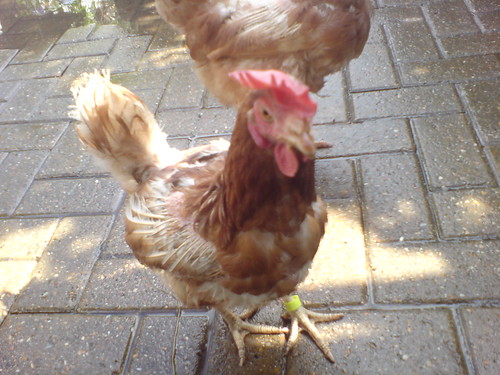
Here is the lovely Chicken 11. She is so sweet but still very scared of everything!
She now, however, has the confidence to let me take a closer photo of her.
You can see her comb has shrunk and is a lot redder now. When she first came it was almost white and covered her right eye! Poor little thing.
She still has a long way to go on the feather growth, but she's looking a lot healthier!
Here is Terri. She still only has her downy under feathers on her chest, and is still missing the top feathers on her wings.
She's very friendly and seems pretty confident around us now.
All of them will take food from your hand now and are all quite happy to be handled.
You can see Terri's comb and face are pretty red and a nice size now.
She's put on weight and is gaining condition nicely.
Here is Chicken 11 again with Crispy stood next to her.
Chicken 11 took a lot longer than the others before she'd come into our house. As you can see here though, she's made herself at home by the back door.
I put a towel down for them to sit on as they're not house trained! I'm still working on that......
Here is Mel. Super confident and very much at home.
I think she really wished she was a cat at this point. Everytime the door was open, she'd walk in. She would quite happily waltz into the lounge and plonk herself down on the carpet. Cheeky thing!
I had to stop them coming into the lounge however, chicken poop is quite hard to clean off of carpet!
You can see that this lady has no fear. It's really something when an animal totally accepts you like this. I love this birdie!
Here are the girls enjoying one of their new found favorite foods, natural yoghurt!
It's actually quite good for them to have some now and again, as it helps to maintain the health of their crop (food pouch).
Chicken 11 is at the front, then Crispy and that's Mel's bottom in the back!
It had been raining, the girls have already expressed their displeasure at heavy rain....
It was really lovely to watch these girls turn back into hens again, as before they came here, they were mere machines.
At the end of the 3rd month, October, Terri developed a bumblefoot. This is an infection on the underside of the foot.
Starts off with a bit of lameness, accompanied with some heat and a little swelling, maybe some redness... if there is a serious infection, you may have a mini abscess on the foot which will burst. If this happens, there will be an open sore, most likely producing pus.
We noticed that Terri was a bit 'off' and had a slight limp on morning. (this is why it is important to watch your hens when you let them out in the morning) I checked her foot and couldn't really see much, so I watched her for a day and waited till the next morning to see how she was.
The next morning, she was no better and the swelling was more apparent. I also noticed a tiny scratch on the sole of her foot. Immediately I bathed it with some cooled, boiled water with salt in.
I decided that as there was an open wound (albeit small) to bring her into the house, as she was really quite lame on it by now.
We set up a travel cot in the lounge and put a cat box in there for a place to hide. I lined the floor of the cot with newspaper and put a water and food dish out for her.
She seemed pretty happy with her new 'house'.
I bathed the foot at least 3 times a day and used antbacterial hand cleaner to keep the foot clean. I did try bandaging the foot, but that is easier said than done on a chicken.....
She stayed in the house for 4 days, till all traces of heat and swelling had gone.
Here is Mel visiting Terri in her 'sick bed'. We thought Terri might get lonely, so we let Mel come and visit her.
Also we were worried that the others might forget her and we'd then have trouble integrating her back into the 'flock'.
The blue is a plastic sheet that we put down instead of the newspaper.... hens poo a lot!
Anyone thinking of doing this with their hen, should be aware that they aren't the most fragrant of animals.... our house stunk, despite cleaning her out lots and lots everyday!
Terri happily made a full recovery from this.... no abscess ever developed and I think we caught it really early...
I checked all the perches and sanded them down, as this injury is commonly caused by splinters on perches.... I think though, she may have stood on a stick or something, because all the perches were fine.
If your hen gets a 'bumblefoot' be careful. I have experience dealing with animal injuries at work with horses and I've always had pets. If you're not sure what you're doing, then take your hen to the vet. She may need antibiotics.
In this case however, it was just a case of reducing heat and swelling and keeping the small wound clean.
When we let Terri out again, bearing in mind she'd been in for 4 days, the others did give her a little bit of a hard time.... but hens need to assert themselves into 'their places' and you have to let them get on with it.
I'll talk about hen integration in another post, as Ginger (one of our newer hens) was a nightmare and will be a better example of that!
Now then, is our girls first autumn! They're all doing really well and eating lots!!
In the next post I'll talk about how their first winter went. I've got lots of hens in the snow pictures!
Thanks for reading.
So, here are some more photos and about how they progressed 2-3 months after we bought them home.
We still only have the 4 hens at this point, Mel, Crispy, Chicken 11 and Terri.

Here is the lovely Chicken 11. She is so sweet but still very scared of everything!
She now, however, has the confidence to let me take a closer photo of her.
You can see her comb has shrunk and is a lot redder now. When she first came it was almost white and covered her right eye! Poor little thing.
She still has a long way to go on the feather growth, but she's looking a lot healthier!
Here is Terri. She still only has her downy under feathers on her chest, and is still missing the top feathers on her wings.
She's very friendly and seems pretty confident around us now.
All of them will take food from your hand now and are all quite happy to be handled.
You can see Terri's comb and face are pretty red and a nice size now.
She's put on weight and is gaining condition nicely.
Here is Chicken 11 again with Crispy stood next to her.
Chicken 11 took a lot longer than the others before she'd come into our house. As you can see here though, she's made herself at home by the back door.
I put a towel down for them to sit on as they're not house trained! I'm still working on that......
Here is Mel. Super confident and very much at home.
I think she really wished she was a cat at this point. Everytime the door was open, she'd walk in. She would quite happily waltz into the lounge and plonk herself down on the carpet. Cheeky thing!
I had to stop them coming into the lounge however, chicken poop is quite hard to clean off of carpet!
You can see that this lady has no fear. It's really something when an animal totally accepts you like this. I love this birdie!
Here are the girls enjoying one of their new found favorite foods, natural yoghurt!
It's actually quite good for them to have some now and again, as it helps to maintain the health of their crop (food pouch).
Chicken 11 is at the front, then Crispy and that's Mel's bottom in the back!
It had been raining, the girls have already expressed their displeasure at heavy rain....
It was really lovely to watch these girls turn back into hens again, as before they came here, they were mere machines.
At the end of the 3rd month, October, Terri developed a bumblefoot. This is an infection on the underside of the foot.
Starts off with a bit of lameness, accompanied with some heat and a little swelling, maybe some redness... if there is a serious infection, you may have a mini abscess on the foot which will burst. If this happens, there will be an open sore, most likely producing pus.
We noticed that Terri was a bit 'off' and had a slight limp on morning. (this is why it is important to watch your hens when you let them out in the morning) I checked her foot and couldn't really see much, so I watched her for a day and waited till the next morning to see how she was.
The next morning, she was no better and the swelling was more apparent. I also noticed a tiny scratch on the sole of her foot. Immediately I bathed it with some cooled, boiled water with salt in.
I decided that as there was an open wound (albeit small) to bring her into the house, as she was really quite lame on it by now.
We set up a travel cot in the lounge and put a cat box in there for a place to hide. I lined the floor of the cot with newspaper and put a water and food dish out for her.
She seemed pretty happy with her new 'house'.
I bathed the foot at least 3 times a day and used antbacterial hand cleaner to keep the foot clean. I did try bandaging the foot, but that is easier said than done on a chicken.....
She stayed in the house for 4 days, till all traces of heat and swelling had gone.
Here is Mel visiting Terri in her 'sick bed'. We thought Terri might get lonely, so we let Mel come and visit her.
Also we were worried that the others might forget her and we'd then have trouble integrating her back into the 'flock'.
The blue is a plastic sheet that we put down instead of the newspaper.... hens poo a lot!
Anyone thinking of doing this with their hen, should be aware that they aren't the most fragrant of animals.... our house stunk, despite cleaning her out lots and lots everyday!
Terri happily made a full recovery from this.... no abscess ever developed and I think we caught it really early...
I checked all the perches and sanded them down, as this injury is commonly caused by splinters on perches.... I think though, she may have stood on a stick or something, because all the perches were fine.
If your hen gets a 'bumblefoot' be careful. I have experience dealing with animal injuries at work with horses and I've always had pets. If you're not sure what you're doing, then take your hen to the vet. She may need antibiotics.
In this case however, it was just a case of reducing heat and swelling and keeping the small wound clean.
When we let Terri out again, bearing in mind she'd been in for 4 days, the others did give her a little bit of a hard time.... but hens need to assert themselves into 'their places' and you have to let them get on with it.
I'll talk about hen integration in another post, as Ginger (one of our newer hens) was a nightmare and will be a better example of that!
Now then, is our girls first autumn! They're all doing really well and eating lots!!
In the next post I'll talk about how their first winter went. I've got lots of hens in the snow pictures!
Thanks for reading.
Tuesday 23 August 2011
Our ex-battery hens... a month into their new life
Hello,
I found some lovely photos of our girls a month into their 'retirement'. We brought the girls home mid-July 2010, just to give you some idea of when these photos were taken.
Here is Mel in the pumpkin patch (which used to be a veg patch, but we had no idea how big pumpkins grow!!)
The hens loved it in here, shelter from the sun and rain and plenty of bugs to munch!
They pecked at a few of the baby pumpkins, but generally the worst thing they did was to dig up the anti-weed sheets over the soil.
Here is Mel (sitting on the door mat) and Crispy. Mel settled into her new life very quickly and made herself at home.
The others, like Crispy, are happy just to keep their distance a little bit.
We were very happy just to let them be and watch them find their feet. No point trying to rush them, they are still a little thin and have a long way to go before they are up to full strength.
Here is Crispy (stood up) and Chicken 11.
Chicken 11 was the weakest and most timid of the hens and she did get picked on a little to start with. Once the hierarchy was established however, Chicken 11 and Crispy became very close. They would be together all the time, eat together and graze the lawn together.
It was lovely to watch this friendship develop. When we lost chicken 11 this year, Crispy did actually look a bit lost, but has since become closer to Mel.
Here is Terri. She was another very friendly hen in the end, but it did take her quite a while to come out of her shell.
You can see the water drinker and feed bowl in the background. The water is pink due to a vitamin supplement to help the girls recover more quickly. The silver bowl was used as the girls refused to eat pellets, and refused to eat out of a feeder.... so they had wet mash in the silver bowl for about 6 months, till we managed to coax them over to dry feed from a feeder, not pellets, but at least it's dry!
Crispy and Chicken 11 again. Anyone who thinks these creatures have no soul, brain or ability to form a lasting friendship is sadly mistaken.... these two were inseparable. Crispy was happy to be with the others and I think she gave Chicken 11 a lot of confidence, Mel still tried to pick on 11 but Crispy quietly stood up for her, no fighting, she just kind of put herself between them.
It just shows how clever these girls are.
The girls settled well and as we had gotten the four ladies together, we didn't really have any trouble with fighting. As I mentioned, Chicken 11 had a bit of a hard time, mostly from Mel, but once her and Crispy got together, that all changed.
They were all perching quite happily at night by now, although Mel still preferred to sleep in the nest box (I would too!) and she still does!
We were very lucky, as none of the girls got injured or ill in the first couple of months.
This is a fun game. I got the idea from another YouTube video.
I was looking for ways to get the girls active and give them new things to do.
As we'd had them a month already, they were fairly strong.
Sorry about the picture quality, but it was a year ago!! LOL!
Here is a video of Mel sleeping in our house! She walked in, sat down and fell asleep.
She was also making some lovely cooing noises, but I wasn't able to catch them on here.
It just shows how content and settled she was, even at this early stage!
and finally, here is Crispy having one of her 'moments!'.
Generally the hens are very quiet, but now and again they like to make themselves heard!!
Thank you again for reading. I'll write again soon about them as they came up to their first winter. We had one injured hen and a heck of a lot of snow!
I found some lovely photos of our girls a month into their 'retirement'. We brought the girls home mid-July 2010, just to give you some idea of when these photos were taken.
Here is Mel in the pumpkin patch (which used to be a veg patch, but we had no idea how big pumpkins grow!!)
The hens loved it in here, shelter from the sun and rain and plenty of bugs to munch!
They pecked at a few of the baby pumpkins, but generally the worst thing they did was to dig up the anti-weed sheets over the soil.
Here is Mel (sitting on the door mat) and Crispy. Mel settled into her new life very quickly and made herself at home.
The others, like Crispy, are happy just to keep their distance a little bit.
We were very happy just to let them be and watch them find their feet. No point trying to rush them, they are still a little thin and have a long way to go before they are up to full strength.
Here is Crispy (stood up) and Chicken 11.
Chicken 11 was the weakest and most timid of the hens and she did get picked on a little to start with. Once the hierarchy was established however, Chicken 11 and Crispy became very close. They would be together all the time, eat together and graze the lawn together.
It was lovely to watch this friendship develop. When we lost chicken 11 this year, Crispy did actually look a bit lost, but has since become closer to Mel.
Here is Terri. She was another very friendly hen in the end, but it did take her quite a while to come out of her shell.
You can see the water drinker and feed bowl in the background. The water is pink due to a vitamin supplement to help the girls recover more quickly. The silver bowl was used as the girls refused to eat pellets, and refused to eat out of a feeder.... so they had wet mash in the silver bowl for about 6 months, till we managed to coax them over to dry feed from a feeder, not pellets, but at least it's dry!
Crispy and Chicken 11 again. Anyone who thinks these creatures have no soul, brain or ability to form a lasting friendship is sadly mistaken.... these two were inseparable. Crispy was happy to be with the others and I think she gave Chicken 11 a lot of confidence, Mel still tried to pick on 11 but Crispy quietly stood up for her, no fighting, she just kind of put herself between them.
It just shows how clever these girls are.
The girls settled well and as we had gotten the four ladies together, we didn't really have any trouble with fighting. As I mentioned, Chicken 11 had a bit of a hard time, mostly from Mel, but once her and Crispy got together, that all changed.
They were all perching quite happily at night by now, although Mel still preferred to sleep in the nest box (I would too!) and she still does!
We were very lucky, as none of the girls got injured or ill in the first couple of months.
This is a fun game. I got the idea from another YouTube video.
I was looking for ways to get the girls active and give them new things to do.
As we'd had them a month already, they were fairly strong.
Sorry about the picture quality, but it was a year ago!! LOL!
Here is a video of Mel sleeping in our house! She walked in, sat down and fell asleep.
She was also making some lovely cooing noises, but I wasn't able to catch them on here.
It just shows how content and settled she was, even at this early stage!
and finally, here is Crispy having one of her 'moments!'.
Generally the hens are very quiet, but now and again they like to make themselves heard!!
Thank you again for reading. I'll write again soon about them as they came up to their first winter. We had one injured hen and a heck of a lot of snow!
Monday 22 August 2011
But what about battery hens?
Now, I'm not going to go all preachy or anything, so don't worry, but I would like to provide you with some information so you can make up your own mind.
I just wanted to put some of the information I found before getting my hens together, so you can see what these ladies have gone through and just how far they've come.
Lets have a look at one of my hens.... Mel, as she is and always has been the easiest to get really close to.
Here is Mel a couple of weeks after she came to live with us.
You can see how much redder her face and comb are, although they still have a long way to go.
Mel and her friends, are 'hybrid' hens. A commercially produced bird of mixed breeds to optimize egg production.
Once she is fully healthy, her feathers should be smooth and shiny, her face should be red and her comb will be smaller.
Again, this shows the adaptable nature of the chicken.
The hens comb regulates body temperature. Ex-battery hens will never have been outside and will have been shut in a hot, cramped environment under artificial lighting. I'm no expert, but I assume because of being kept in this way, the comb has enlarged to compensate for the constant hot temperature.
This is a photo from the Torquay Girls Grammer School citzienship blog. This is a UK battery farm. This is what my hens have come from. I should imagine there are worse ones than this, but this is, in my opinion, nothing short of hen hell. No sunlight, no grass, no soil, no space, just row upon row of hens.....
I can't imagine how hot, smelly, noisy and just plain awful it must be in here.
As well as Mels' comb size and the colour of her face, you will also notice her lack of feathering, she has quite a good covering on her neck, but her wings are quite bare and her bottom is bald!
Here is Mel again, this time having a sunbathe by the pumpkin patch.
You can clearly see how sparse her feathers are.... she has puffed her neck feathers out here (to catch some extra rays!) but all in all, she looks pretty pathetic.... but saying that, she has a darn sight more feathers than some hens who come out of a battery farm.
A battery hen will have spent her whole life stood in a cage, with at least 4 other hens... now, hens aren't stupid, they get frustrated and irritated like any of us, so with a lack of space, overcrowding, heat, discomfort from being stood on wire mesh the whole time and nothing to see or keep her occupied, fights are going to happen.
When mine eat, the boss hen goes first, if that's not respected by the others, they get a smart tap on the head.... I would imagine in the battery farm the pecks carry on as they just can;t move out of each others way. They pull each others feathers out, case injury and some I imagine will even be killed.
If a hen manages to draw blood from another, they will just keep attacking, brutal.
As well as losing feathers from pecking or pulling, the hen will of course loose some from constantly rubbing against the sides, top and bottom of the cage.
This picture is from a 'Happy Egg' farm in NZ and was rescued by the Action Animal Rescue Team.
You can see the difference! Poor little lady.
Preventing boredom is therefore very important. Space is the best boredom prevention! Not having enough space also helps disease and parasites to spread very quickly.
The sort of things that a battery hen may suffer from include.....
❂ Mareks disease- a virus which causes internal lesions, a bit like a cancer. It is spread through the respiratory tract, so as you can imagine, would spread very quickly in a battery farm.
❂ Impacted eggs or egg bound- this is where a fully formed egg become lodged inside the hen. This is extremely serious and can be fatal. In a battery farm, I would imagine an egg bound hen would most likely not even be noticed....
❂ Broken and/or brittle bones also known as 'cage layer fatigue'- Due to the battery hen having been bred specifically for the purposes of laying loads of eggs, this can lead to suffering from osteoporosis (brittle bones) as all of the hens calcium reserves will have been used for laying eggs. I would imagine also, that never have been exposed to sunlight would also cause them to have a vitamin D deficiency, which is also essential for healthy, strong bones. As the bones become brittle, they break, due to getting a foot stuck, poor handling, fighting.... the list goes on....
❂ Prolapse- This is a distressing condition. We sadly lost Chicken 11 due to prolapse. This is where the hens uterus 'falls out' of the vagina... sometimes, if caught early enough, or it's not too bad the hen can be saved, or surgery can also be an option. In a battery farm it would most likely go un-noticed, also as I mentioned above, when a hen sees blood, they attack.... I don't think I need to say anymore, it's just gruesome.
❂ Fatty liver syndrome- The hens get no exercise, they eat, they lay.... that's it. So the liver cannot cope and fails.
❂ Stress- Perhaps the most obvious one of all, the hen my have known no different, but it still must be horribly stressful for her. Having no privacy to lay, being crammed in a cage, fighting for food, being pecked, being kept in a hot, stuffy environment, laying more eggs than her body is naturally supposed too.... Sadly, when hens are finally found a new home, they can die within a few days due to it just all being too much.
❂ Overgrown beak and claws- Having been sat in a cage and not moving, the claws and beak are not worn down naturally, so they maybe overgrown.
It used to be common practise to 'de-beak- a battery hen. This involves slicing the tip of the top half of the beak off with a red hot blade when the hen is young, it's mean to stop the hens injuring each other when they peck.
These are just some of the more common health problems that I was able to find out about. Now I shall tell you about the life cycle of a battery hen. This is researched from various places on the web that I found whilst I was finding out about battery hens myself.
Video taken inside a battery hen farm by some Australian activists. This is a simple video, no preachy commentary, you just watch. It's not nice but then nothing about battery farming is nice.
The life of a battery hen begins when she is hatched, day one. The chicks are passed along a conveyor belt and sexed... the hens are kept and the males are 'dispatched'. This can either be by gassing, dropping into a mincer or just shoved in a bin liner with the rest to suffocate. Nice.
Before a hen is old enough to lay eggs, she is either reared in a shed or in a special cage. Then at 18 weeks old, they maybe de-beaked and then put into the battery cage.
This is a cage which was retrieved by the United Poultry Concerns from an abandoned battery farm. They have put some model hens in the cage to clearly show just how little space the hens actually have. The current cages are 20 inches by 20 inches..... a hens wing span is about 36 inches, there are about 5-6 hens in one cage.... think about that for a moment.
The law is changing, from January 2012 the current cages (shown above) will be banned and the new 'enriched' cages will replace them.... The cage shown here on the left is one of the new style cages.... spot the difference. These cages are 10 inches by 11 inches per hen and have to provide 15cms of perch per hen. So they have a bit more room, but it's not much of an improvement.
In order to maximise egg production, the sheds containing the cages are artificially lit for 17 hours a day. The floor of the cages are sloped forwards, so that the eggs roll out onto a conveyor belt. The droppings fall through the cage floor onto another conveyor belt. The average battery hen will produce around 338 eggs per year.... that's a lot of eggs.
An egg normally takes about 24-26 hours to 'make' a normal laying hen, will lay about 257 eggs per year. This is almost 100 eggs less per year than a battery hen!! No wonder the poor things look rubbish!
The hens remain in the battery cage until they are about 18-24 months old, when they are then considered spent and are slaughtered. Their meat is very poor quality and is used in pet food, chicken stocks, cheap pies etc..... yum.
I hope that this goes someway to helping you understand what it means to be a battery hen and indeed an ex-battery hen. I've never been inside a battery farm and to be honest, I wouldn't want to. It's a cruel and barbaric farming method which is not just limited to hens, but I'll just focus on the hens for the time being.
Here is Mel now, this is what she looks like after just over a year out of the battery farm.
Look at her beautiful red face and perky red comb. She is still missing a few feathers round the top of her legs, but everything else is covered in lovely glossy, brown feathers.
She is cheeky, happy, totally spoiled and a joy to have around.
Here she is scratching my leg. As soon as I sat down, she came over to see what I was up to. The whole time she was cooing at me.
How could anyone say she was happy in the battery farm?
Thanks for reading. I've tried to keep it neutral, but I feel very strongly about this subject.
I just wanted to put some of the information I found before getting my hens together, so you can see what these ladies have gone through and just how far they've come.
Lets have a look at one of my hens.... Mel, as she is and always has been the easiest to get really close to.
Here is Mel a couple of weeks after she came to live with us.
You can see how much redder her face and comb are, although they still have a long way to go.
Mel and her friends, are 'hybrid' hens. A commercially produced bird of mixed breeds to optimize egg production.
Once she is fully healthy, her feathers should be smooth and shiny, her face should be red and her comb will be smaller.
Again, this shows the adaptable nature of the chicken.
The hens comb regulates body temperature. Ex-battery hens will never have been outside and will have been shut in a hot, cramped environment under artificial lighting. I'm no expert, but I assume because of being kept in this way, the comb has enlarged to compensate for the constant hot temperature.
This is a photo from the Torquay Girls Grammer School citzienship blog. This is a UK battery farm. This is what my hens have come from. I should imagine there are worse ones than this, but this is, in my opinion, nothing short of hen hell. No sunlight, no grass, no soil, no space, just row upon row of hens.....
I can't imagine how hot, smelly, noisy and just plain awful it must be in here.
As well as Mels' comb size and the colour of her face, you will also notice her lack of feathering, she has quite a good covering on her neck, but her wings are quite bare and her bottom is bald!
Here is Mel again, this time having a sunbathe by the pumpkin patch.
You can clearly see how sparse her feathers are.... she has puffed her neck feathers out here (to catch some extra rays!) but all in all, she looks pretty pathetic.... but saying that, she has a darn sight more feathers than some hens who come out of a battery farm.
A battery hen will have spent her whole life stood in a cage, with at least 4 other hens... now, hens aren't stupid, they get frustrated and irritated like any of us, so with a lack of space, overcrowding, heat, discomfort from being stood on wire mesh the whole time and nothing to see or keep her occupied, fights are going to happen.
When mine eat, the boss hen goes first, if that's not respected by the others, they get a smart tap on the head.... I would imagine in the battery farm the pecks carry on as they just can;t move out of each others way. They pull each others feathers out, case injury and some I imagine will even be killed.
If a hen manages to draw blood from another, they will just keep attacking, brutal.
As well as losing feathers from pecking or pulling, the hen will of course loose some from constantly rubbing against the sides, top and bottom of the cage.
This picture is from a 'Happy Egg' farm in NZ and was rescued by the Action Animal Rescue Team.
You can see the difference! Poor little lady.
Preventing boredom is therefore very important. Space is the best boredom prevention! Not having enough space also helps disease and parasites to spread very quickly.
The sort of things that a battery hen may suffer from include.....
❂ Mareks disease- a virus which causes internal lesions, a bit like a cancer. It is spread through the respiratory tract, so as you can imagine, would spread very quickly in a battery farm.
❂ Impacted eggs or egg bound- this is where a fully formed egg become lodged inside the hen. This is extremely serious and can be fatal. In a battery farm, I would imagine an egg bound hen would most likely not even be noticed....
❂ Broken and/or brittle bones also known as 'cage layer fatigue'- Due to the battery hen having been bred specifically for the purposes of laying loads of eggs, this can lead to suffering from osteoporosis (brittle bones) as all of the hens calcium reserves will have been used for laying eggs. I would imagine also, that never have been exposed to sunlight would also cause them to have a vitamin D deficiency, which is also essential for healthy, strong bones. As the bones become brittle, they break, due to getting a foot stuck, poor handling, fighting.... the list goes on....
❂ Prolapse- This is a distressing condition. We sadly lost Chicken 11 due to prolapse. This is where the hens uterus 'falls out' of the vagina... sometimes, if caught early enough, or it's not too bad the hen can be saved, or surgery can also be an option. In a battery farm it would most likely go un-noticed, also as I mentioned above, when a hen sees blood, they attack.... I don't think I need to say anymore, it's just gruesome.
❂ Fatty liver syndrome- The hens get no exercise, they eat, they lay.... that's it. So the liver cannot cope and fails.
❂ Stress- Perhaps the most obvious one of all, the hen my have known no different, but it still must be horribly stressful for her. Having no privacy to lay, being crammed in a cage, fighting for food, being pecked, being kept in a hot, stuffy environment, laying more eggs than her body is naturally supposed too.... Sadly, when hens are finally found a new home, they can die within a few days due to it just all being too much.
❂ Overgrown beak and claws- Having been sat in a cage and not moving, the claws and beak are not worn down naturally, so they maybe overgrown.
It used to be common practise to 'de-beak- a battery hen. This involves slicing the tip of the top half of the beak off with a red hot blade when the hen is young, it's mean to stop the hens injuring each other when they peck.
These are just some of the more common health problems that I was able to find out about. Now I shall tell you about the life cycle of a battery hen. This is researched from various places on the web that I found whilst I was finding out about battery hens myself.
Video taken inside a battery hen farm by some Australian activists. This is a simple video, no preachy commentary, you just watch. It's not nice but then nothing about battery farming is nice.
The life of a battery hen begins when she is hatched, day one. The chicks are passed along a conveyor belt and sexed... the hens are kept and the males are 'dispatched'. This can either be by gassing, dropping into a mincer or just shoved in a bin liner with the rest to suffocate. Nice.
Before a hen is old enough to lay eggs, she is either reared in a shed or in a special cage. Then at 18 weeks old, they maybe de-beaked and then put into the battery cage.
This is a cage which was retrieved by the United Poultry Concerns from an abandoned battery farm. They have put some model hens in the cage to clearly show just how little space the hens actually have. The current cages are 20 inches by 20 inches..... a hens wing span is about 36 inches, there are about 5-6 hens in one cage.... think about that for a moment.
The law is changing, from January 2012 the current cages (shown above) will be banned and the new 'enriched' cages will replace them.... The cage shown here on the left is one of the new style cages.... spot the difference. These cages are 10 inches by 11 inches per hen and have to provide 15cms of perch per hen. So they have a bit more room, but it's not much of an improvement.
In order to maximise egg production, the sheds containing the cages are artificially lit for 17 hours a day. The floor of the cages are sloped forwards, so that the eggs roll out onto a conveyor belt. The droppings fall through the cage floor onto another conveyor belt. The average battery hen will produce around 338 eggs per year.... that's a lot of eggs.
An egg normally takes about 24-26 hours to 'make' a normal laying hen, will lay about 257 eggs per year. This is almost 100 eggs less per year than a battery hen!! No wonder the poor things look rubbish!
The hens remain in the battery cage until they are about 18-24 months old, when they are then considered spent and are slaughtered. Their meat is very poor quality and is used in pet food, chicken stocks, cheap pies etc..... yum.
I hope that this goes someway to helping you understand what it means to be a battery hen and indeed an ex-battery hen. I've never been inside a battery farm and to be honest, I wouldn't want to. It's a cruel and barbaric farming method which is not just limited to hens, but I'll just focus on the hens for the time being.
Here is Mel now, this is what she looks like after just over a year out of the battery farm.
Look at her beautiful red face and perky red comb. She is still missing a few feathers round the top of her legs, but everything else is covered in lovely glossy, brown feathers.
She is cheeky, happy, totally spoiled and a joy to have around.
Here she is scratching my leg. As soon as I sat down, she came over to see what I was up to. The whole time she was cooing at me.
How could anyone say she was happy in the battery farm?
Thanks for reading. I've tried to keep it neutral, but I feel very strongly about this subject.
Friday 19 August 2011
My ex-battery hens, the first days.
Okay, so I thought for this post, I would find some pictures of our hens on their very first days out in the world!!
As mentioned in previous posts, we have 8 gorgeous ex-battery hens from the BHWT (British Hen Welfare Trust). I'll keep mentioning them too because they are amazing. They've rescued over 200,000 hens to date, from what would have been death.... these birds are only about 18 months old when they're considered 'spent' and this is a tragedy. Awareness is growing, but there is still a long way to go....
Anyway, back to my girls!!!
Here they all are in their shiny new home. I showed this picture on an earlier blog post, but I think it catches them perfectly!
The hens need to stay in for the first few days to minimise stress, but ours were keen to explore.
I was at work when they arrived, as my husband and son went to pick them up. They stayed in the run for the first day and just looked shell shocked!! Poor things...
This is Crispy on her first day. Look how pale the face is, how many feathers are missing.
These ladies have quite few feathers compared to some girls that have just come out, but it's heartbreaking to think that there are millions (approx 16 million in this country) of hens kept in battery farms. How is this legal and how can anyone think it's right??
Here is Chicken 11 on her first day. She looks a bit like a road runner here, due to her lack of feathers!!
She was the strangest looking, as her comb was very large and floppy! It covered one of her eyes to start with, she looked everso funny!
She had bald bits, and was the worst condition out of the original 4 hens we had.
This is the second day. We filled a large garden tray with some soil to give them something interesting to do.
They started to scratch about in it and even tried to dust bathe in it!!
We opened the run door and watched.
It was amazing to see these poor, scraggly birds, slowly perk up and explore.
Every moment that went by was something new for them and of course for us! We'd not had hens before, but I'd always wanted some.
The first steps outside!! Mel was the first one to take the big step! She was called Mel after Mel Gibson in Braveheart!
We made a small temporary pen area out of chicken wire and posts, just to give them a boundary.
Hens are actually very good jumpers and can propell themselves with their wings! This pen would not hold them now, but when they first come out of the farm, they are weak and don't know what they're capable of!!
This was their first steps on grass too! Amazing!
Slowly but surely the other girls emerge from the safety of the pen.
This was only their second day with us, but they were keen to get out and about, so we let them.
You can see in this photo the curious nature of the birds. It was raining too, another thing they had never experienced!
Chicken 11 was still inside at this point. Here you can see Crispy, Mel and Terri taking it all in!
Chicken 11 hangs back from the others. She was the weakest and the shyest bird right from the beginning.
She had huge feet, a huge floppy comb and always looked terrified of life! But she had the prettiest face and the sweetest disposition of them all.
The morning of day 3! All of the girls were keen to come outside and explore! The sun was shining, the grass was wet and all the girls survived the night.
I put some mixed corn down, just to see what they would do, but it takes a little while for hens to recognise anything but hen food as edible.... They were only fed Ex-battery crumbs at this point, as it's the closet thing to what they would've eaten in the farm.
Enjoying the sun!! The sun comes out and the feathers start to lift!
Hens love to sunbathe, these girls will have never felt the sun on their backs before and I think this photo shows exactly what they're thinking! Bliss!!
Chicken 11 is the first to hit the deck for a sun bathe!
Mel is stood in the front (blue leg ring) with her feathers all ruffled to allow the sun to penetrate to her skin.
Finally, they're doing hen things! It's amazing how quickly they adapt to their new environment.
I believe, although sadly, that it's this adaptability that allows them to survive in the harsh conditions of the battery farm.
Day 4, Crispy takes her first dirt bath! This is another popular hen activity!
We provided the girls with a large garden tray filled with compost and a large cat litter tray, also filled with compost.
A fun game is to mix meal worms into the compost, they go mad!! Meal worms are the top snack for my girls, but they are also very expensive!
This is about a week after we got these lovely ladies. You can see how un-phased they are by anything!!
Here is my son with his wheel barrow, 'helping' in the garden.... this involved pushing the wheelbarrow at high speed with engine noises.... the hens weren't bothered at all....
You can see how much brighter the hens look already, amazing!
Here is Chicken 11 looking at a piece of corn cob I put in their scratch tray.... she spends a long time making sure it isn't deadly, before taking a closer look......
Chicken 11 and Terri 'attacking' the corn cob.... they've decided it's edible and not evil and eat it very enthusiastically!
Here are Crispy and Mel about a week after we got them.... you can see already, that their combs are starting to redden and they look very much at home!
The bits on the floor are mixed corn and sultanas, although they still haven't worked out that they can eat them yet!
My husband made a perch for them for outside, so far, they weren't too interested, but it takes time.
Here is my husband feeding Mel by hand. Mel has always been the bravest and most people friendly hen.
I think she secretly wants to be a cat, even now she tries to sneak in the house....
This is amazing really, considering how people would have treated them up till now.... they really are wonderful creatures.
Crispy out of the pen! Just over a week at their new home and the girls have shown real interest in the rest of the garden!
We decide to open the pen and see if they want to roam!
Here is Crispy on the patio, you can see her straining her neck to get a closer look at everything. The tail is up and she's fully stretched out! What a beauty!
My husband makes a permanent pen for the girls. This gives them their own space and gives our cats a break too!!!
The gates are open (both ends) during the day when we're home, but they stay in here if the weather is really bad, or we go out for the day.
Although they have a huge run, they feel a bit hard done by if they have to stay in, so this is a compromise!
Terri meets one of our cats, Spice.
Spice is fairly indifferent to the hens, and even now, she shows respect and stays out of their way, but doesn't run, unlike the two male cats we have. The hens will chase the male cats, but seem to leave Spice alone.
You can see Terri sizing Spice up here.... looks like trouble!
Mealworms!!! As previously mentioned, meal worms are the favorite treat of my hens (and any hen I would think!!). We have given them dried and live. They show no preference between the two!
The worms are always met with exciting noises and the hens will jump on top of each other to get to them. It's very funny to see them get so over excited about food!!
Crispy in the flower bed. Now, when you have hens, unless you are willing to put fences up everywhere of have space to give them their own garden, having a flowerbed is near impossible.
This was my flowerbed before hens..... now, only the lavender and sunflowers survive!!
I have a gooseberry bush now which seems to be alive still, but I've yet to have a chance to eat any of the gooseberries!! Cheeky minxes!
I'll finish there for now, but I'll do another few posts with some more photos of our girls. If you're thinking of getting hens, I can't recommend it enough, they are intelligent (but do stupid things sometimes), hilarious, friendly, affectionate and brilliant pets for children.
The ex-battery hens are so rewarding. You rescue these pathetic looking birds, and can watch them blossom in your care. A year down the road for us, and these birds look completely different!
Crispy nowadays, look at the difference! She has all of her feathers, a bright red face and comb and she's a normal, albeit cheeky, hen!
She loves nothing more than digging in the dirt, finding worms, begging for treats (banging on the catflap till I notice and give them something) and she loves human company!
If you're thinking about getting hens, do it..... do it now!!!
Here is Mel giving us a 'hint' that she maybe ready to leave the pen..... subtle is not her middle name!!
Thanks for reading, I hope you find this interesting. I love my hens and I love sharing them with everyone.
As mentioned in previous posts, we have 8 gorgeous ex-battery hens from the BHWT (British Hen Welfare Trust). I'll keep mentioning them too because they are amazing. They've rescued over 200,000 hens to date, from what would have been death.... these birds are only about 18 months old when they're considered 'spent' and this is a tragedy. Awareness is growing, but there is still a long way to go....
Anyway, back to my girls!!!
Here they all are in their shiny new home. I showed this picture on an earlier blog post, but I think it catches them perfectly!
The hens need to stay in for the first few days to minimise stress, but ours were keen to explore.
I was at work when they arrived, as my husband and son went to pick them up. They stayed in the run for the first day and just looked shell shocked!! Poor things...
This is Crispy on her first day. Look how pale the face is, how many feathers are missing.
These ladies have quite few feathers compared to some girls that have just come out, but it's heartbreaking to think that there are millions (approx 16 million in this country) of hens kept in battery farms. How is this legal and how can anyone think it's right??
Here is Chicken 11 on her first day. She looks a bit like a road runner here, due to her lack of feathers!!
She was the strangest looking, as her comb was very large and floppy! It covered one of her eyes to start with, she looked everso funny!
She had bald bits, and was the worst condition out of the original 4 hens we had.
This is the second day. We filled a large garden tray with some soil to give them something interesting to do.
They started to scratch about in it and even tried to dust bathe in it!!
We opened the run door and watched.
It was amazing to see these poor, scraggly birds, slowly perk up and explore.
Every moment that went by was something new for them and of course for us! We'd not had hens before, but I'd always wanted some.
The first steps outside!! Mel was the first one to take the big step! She was called Mel after Mel Gibson in Braveheart!
We made a small temporary pen area out of chicken wire and posts, just to give them a boundary.
Hens are actually very good jumpers and can propell themselves with their wings! This pen would not hold them now, but when they first come out of the farm, they are weak and don't know what they're capable of!!
This was their first steps on grass too! Amazing!
Slowly but surely the other girls emerge from the safety of the pen.
This was only their second day with us, but they were keen to get out and about, so we let them.
You can see in this photo the curious nature of the birds. It was raining too, another thing they had never experienced!
Chicken 11 was still inside at this point. Here you can see Crispy, Mel and Terri taking it all in!
Chicken 11 hangs back from the others. She was the weakest and the shyest bird right from the beginning.
She had huge feet, a huge floppy comb and always looked terrified of life! But she had the prettiest face and the sweetest disposition of them all.
The morning of day 3! All of the girls were keen to come outside and explore! The sun was shining, the grass was wet and all the girls survived the night.
I put some mixed corn down, just to see what they would do, but it takes a little while for hens to recognise anything but hen food as edible.... They were only fed Ex-battery crumbs at this point, as it's the closet thing to what they would've eaten in the farm.
Enjoying the sun!! The sun comes out and the feathers start to lift!
Hens love to sunbathe, these girls will have never felt the sun on their backs before and I think this photo shows exactly what they're thinking! Bliss!!
Chicken 11 is the first to hit the deck for a sun bathe!
Mel is stood in the front (blue leg ring) with her feathers all ruffled to allow the sun to penetrate to her skin.
Finally, they're doing hen things! It's amazing how quickly they adapt to their new environment.
I believe, although sadly, that it's this adaptability that allows them to survive in the harsh conditions of the battery farm.
Day 4, Crispy takes her first dirt bath! This is another popular hen activity!
We provided the girls with a large garden tray filled with compost and a large cat litter tray, also filled with compost.
A fun game is to mix meal worms into the compost, they go mad!! Meal worms are the top snack for my girls, but they are also very expensive!
This is about a week after we got these lovely ladies. You can see how un-phased they are by anything!!
Here is my son with his wheel barrow, 'helping' in the garden.... this involved pushing the wheelbarrow at high speed with engine noises.... the hens weren't bothered at all....
You can see how much brighter the hens look already, amazing!
Here is Chicken 11 looking at a piece of corn cob I put in their scratch tray.... she spends a long time making sure it isn't deadly, before taking a closer look......
Chicken 11 and Terri 'attacking' the corn cob.... they've decided it's edible and not evil and eat it very enthusiastically!
Here are Crispy and Mel about a week after we got them.... you can see already, that their combs are starting to redden and they look very much at home!
The bits on the floor are mixed corn and sultanas, although they still haven't worked out that they can eat them yet!
My husband made a perch for them for outside, so far, they weren't too interested, but it takes time.
Here is my husband feeding Mel by hand. Mel has always been the bravest and most people friendly hen.
I think she secretly wants to be a cat, even now she tries to sneak in the house....
This is amazing really, considering how people would have treated them up till now.... they really are wonderful creatures.
Crispy out of the pen! Just over a week at their new home and the girls have shown real interest in the rest of the garden!
We decide to open the pen and see if they want to roam!
Here is Crispy on the patio, you can see her straining her neck to get a closer look at everything. The tail is up and she's fully stretched out! What a beauty!
My husband makes a permanent pen for the girls. This gives them their own space and gives our cats a break too!!!
The gates are open (both ends) during the day when we're home, but they stay in here if the weather is really bad, or we go out for the day.
Although they have a huge run, they feel a bit hard done by if they have to stay in, so this is a compromise!
Terri meets one of our cats, Spice.
Spice is fairly indifferent to the hens, and even now, she shows respect and stays out of their way, but doesn't run, unlike the two male cats we have. The hens will chase the male cats, but seem to leave Spice alone.
You can see Terri sizing Spice up here.... looks like trouble!
Mealworms!!! As previously mentioned, meal worms are the favorite treat of my hens (and any hen I would think!!). We have given them dried and live. They show no preference between the two!
The worms are always met with exciting noises and the hens will jump on top of each other to get to them. It's very funny to see them get so over excited about food!!
Crispy in the flower bed. Now, when you have hens, unless you are willing to put fences up everywhere of have space to give them their own garden, having a flowerbed is near impossible.
This was my flowerbed before hens..... now, only the lavender and sunflowers survive!!
I have a gooseberry bush now which seems to be alive still, but I've yet to have a chance to eat any of the gooseberries!! Cheeky minxes!
I'll finish there for now, but I'll do another few posts with some more photos of our girls. If you're thinking of getting hens, I can't recommend it enough, they are intelligent (but do stupid things sometimes), hilarious, friendly, affectionate and brilliant pets for children.
The ex-battery hens are so rewarding. You rescue these pathetic looking birds, and can watch them blossom in your care. A year down the road for us, and these birds look completely different!
Crispy nowadays, look at the difference! She has all of her feathers, a bright red face and comb and she's a normal, albeit cheeky, hen!
She loves nothing more than digging in the dirt, finding worms, begging for treats (banging on the catflap till I notice and give them something) and she loves human company!
If you're thinking about getting hens, do it..... do it now!!!
Here is Mel giving us a 'hint' that she maybe ready to leave the pen..... subtle is not her middle name!!
Thanks for reading, I hope you find this interesting. I love my hens and I love sharing them with everyone.
Subscribe to:
Posts (Atom)












